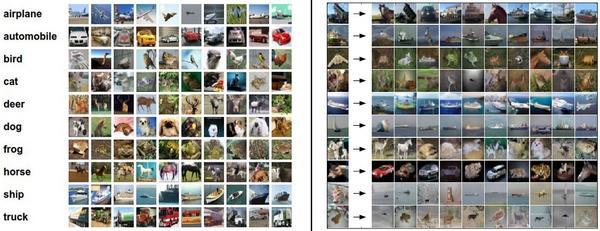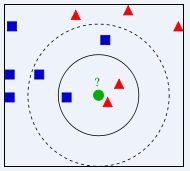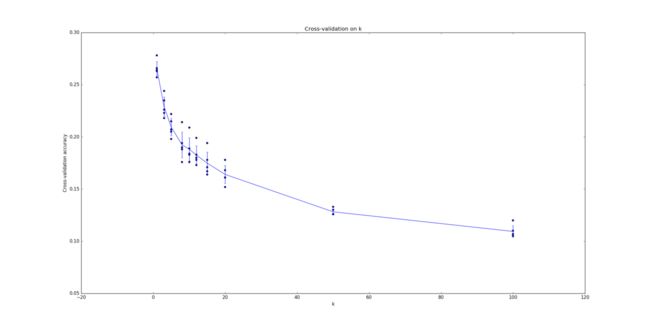cs231n课程作业assignment1(KNN)
前言:
以斯坦福cs231n课程的python编程任务为主线,展开对该课程主要内容的理解和部分数学推导。
该课程相关笔记参考自知乎-CS231n官方笔记授权翻译总集篇发布
k-Nearest Neighbor分类器简介:
k-Nearest Neighbor,简称KNN,翻译过来的意思就是k邻近分类,一个测试与已知的训练集中的数据进行求欧氏距离运算,取前K个距离最短的数据,然后根据前K个数据中标签出现次数最多的便为该测试的标签,更高的k值可以让分类的效果更平滑,使得分类器对于异常值更有抵抗力。
KNN原理
图像分类数据集:CIFAR-10。这个数据集包含了60000张32X32的小图像。每张图像都有10种分类标签中的一种。这60000张图像被分为包含50000张图像的训练集和包含10000张图像的测试集。在下图中你可以看见10个类的10张随机图片。

最简单的求两个数据差异化的方法就是把每个像素相减求平方和,即计算欧氏距离。若不考虑平方的放大效果,可直接做差求和,换句话说,就是将两张图片先转化为两个向量,然后计算他们的距离d:
过程如下:

根据测试图像和已知数据进行比较后可以的得出当前test image和training image的距离关系,在高维度下不好表示,我们将其想象成二维的im(x,y)。然后我们找出距离最近的K个training image的标签,标签出现次数最多的就是当前test image的标签了。
Python实现过程
#coding: utf-8
import numpy as np
class KNearestNeighbor(object):
def __init__(self):
pass
def train(self, X, y):
"""
Train the classifier. For k-nearest neighbors this is just
memorizing the training data.
Inputs:
- X: A numpy array of shape (num_train, D) containing the training data
consisting of num_train samples each of dimension D.
- y: A numpy array of shape (N,) containing the training labels, where
y[i] is the label for X[i].
"""
self.X_train = X
self.y_train = y
def predict(self, X, k=1, num_loops=0):
"""
Predict labels for test data using this classifier.
Inputs:
- X: A numpy array of shape (num_test, D) containing test data consisting
of num_test samples each of dimension D.
- k: The number of nearest neighbors that vote for the predicted labels.
- num_loops: Determines which implementation to use to compute distances
between training points and testing points.
Returns:
- y: A numpy array of shape (num_test,) containing predicted labels for the
test data, where y[i] is the predicted label for the test point X[i].
"""
if num_loops == 0:
dists = self.compute_distances_no_loops(X)
elif num_loops == 1:
dists = self.compute_distances_one_loop(X)
elif num_loops == 2:
dists = self.compute_distances_two_loops(X)
else:
raise ValueError('Invalid value %d for num_loops' % num_loops)
return self.predict_labels(dists, k=k)
def compute_distances_two_loops(self, X):
"""
Compute the distance between each test point in X and each training point
in self.X_train using a nested loop over both the training data and the
test data.
Inputs:
- X: A numpy array of shape (num_test, D) containing test data.
Returns:
- dists: A numpy array of shape (num_test, num_train) where dists[i, j]
is the Euclidean distance between the ith test point and the jth training
point.
"""
num_test = X.shape[0]
num_train = self.X_train.shape[0]
dists = np.zeros((num_test, num_train))
for i in xrange(num_test):
for j in xrange(num_train):
train = self.X_train[j,:]
test = X[i,:]
distence = np.sqrt(np.sum((test-train)**2))#Calculate the eyclidean distance
dists[i,j]=distence
return dists
def compute_distances_one_loop(self, X):
"""
Compute the distance between each test point in X and each training point
in self.X_train using a single loop over the test data.
Input / Output: Same as compute_distances_two_loops
"""
num_test = X.shape[0]
num_train = self.X_train.shape[0]
dists = np.zeros((num_test, num_train))
for i in xrange(num_test):
dis_array = X[i,:]-self.X_train
dists[i,:] = np.sqrt(np.sum(dis_array**2))
return dists
def compute_distances_no_loops(self, X):
"""
Compute the distance between each test point in X and each training point
in self.X_train using no explicit loops.
Input / Output: Same as compute_distances_two_loops
"""
num_test = X.shape[0]
num_train = self.X_train.shape[0]
dists = np.zeros((num_test, num_train))
M = np.dot(X, self.X_train.T)
te = np.square(X).sum(axis = 1)
tr = np.square(self.X_train).sum(axis = 1)
dists = np.sqrt(-2*M+tr+np.matrix(te).T)
dists = np.array(dists)
return dists
def predict_labels(self, dists, k=1):
"""
Given a matrix of distances between test points and training points,
predict a label for each test point.
Inputs:
- dists: A numpy array of shape (num_test, num_train) where dists[i, j]
gives the distance betwen the ith test point and the jth training point.
Returns:
- y: A numpy array of shape (num_test,) containing predicted labels for the
test data, where y[i] is the predicted label for the test point X[i].
"""
num_test = dists.shape[0]
y_pred = np.zeros(num_test)
for i in xrange(num_test):
# A list of length k storing the labels of the k nearest neighbors to
# the ith test point.
closest_y = []
idx = np.argsort(dists[i,:],-1)
closest_y = self.y_train[idx[:k]]
closest_set = set(closest_y)#find max label
for idx,item in enumerate(closest_set):
y_pred[i]= item
if idx == 0:
break
return y_pred详细测试部分:
# coding:utf-8
import random
import numpy as np
from data_utils import load_CIFAR10
import matplotlib.pyplot as plt
plt.rcParams['figure.figsize'] = (10.0, 8.0) # set default size of plots
plt.rcParams['image.interpolation'] = 'nearest'
plt.rcParams['image.cmap'] = 'gray'
cifar10_dir = 'datasets/cifar-10-batches-py'#data_path
X_train, y_train, X_test, y_test = load_CIFAR10(cifar10_dir)
print 'Training data shape: ', X_train.shape
print 'Training labels shape: ', y_train.shape
print 'Test data shape: ', X_test.shape
print 'Test labels shape: ', y_test.shape
num_training = 5000 #the trainning number
mask = range(num_training) #create range number
X_train = X_train[mask]
y_train = y_train[mask]
num_test = 500 #the test number
mask = range(num_test)
X_test = X_test[mask]
y_test = y_test[mask]
# Reshape the image data into rows
X_train = np.reshape(X_train, (X_train.shape[0], -1))#-1 mean auto number
X_test = np.reshape(X_test, (X_test.shape[0], -1))
print X_train.shape, X_test.shape
from classifiers import KNearestNeighbor#import
classifier = KNearestNeighbor()
#classifier.train(X_train, y_train)#data and lable
#dists = classifier.compute_distances_no_loops(X_test)
#print dists.shape
#classifier the test and mark the label
#y_test_pred = classifier.predict_labels(dists, k=7)
#num_correct = np.sum(y_test_pred == y_test)
#accuracy = float(num_correct) / num_test
#print 'Got %d / %d correct => accuracy: %f' % (num_correct, num_test, accuracy)
#compare the different function
def time_function(f, *args):
"""
Call a function f with args and return the time (in seconds) that it took to execute.
"""
import time
tic = time.time()
f(*args)
toc = time.time()
return toc - tic
#two_loop_time = time_function(classifier.compute_distances_two_loops, X_test)
#print 'Two loop version took %f seconds' % two_loop_time
#one_loop_time = time_function(classifier.compute_distances_one_loop, X_test)
#print 'One loop version took %f seconds' % one_loop_time
#the faster than anyother
#no_loop_time = time_function(classifier.compute_distances_no_loops, X_test)
#print 'No loop version took %f seconds' % no_loop_time
num_folds = 5
k_choices = [1, 3, 5, 8, 10, 12, 15, 20, 50, 100]
X_train_folds = []
y_train_folds = []
X_train_folds = np.array_split(X_train, num_folds);#split the array
y_train_folds = np.array_split(y_train, num_folds);
k_to_accuracies = {}
for k in k_choices:
k_to_accuracies[k] = []
for k in k_choices:#find the best k-value
for i in range(num_folds):
X_train_cv = np.vstack(X_train_folds[:i]+X_train_folds[i+1:])
X_test_cv = X_train_folds[i]
y_train_cv = np.hstack(y_train_folds[:i]+y_train_folds[i+1:]) #size:4000
y_test_cv = y_train_folds[i]
classifier.train(X_train_cv, y_train_cv)
dists_cv = classifier.compute_distances_no_loops(X_test_cv)
y_test_pred = classifier.predict_labels(dists_cv, k)
num_correct = np.sum(y_test_pred == y_test_cv)
accuracy = float(num_correct) / y_test_cv.shape[0]
k_to_accuracies[k].append(accuracy)
for k in sorted(k_to_accuracies):
for accuracy in k_to_accuracies[k]:
print 'k = %d, accuracy = %f' % (k, accuracy)
# plot the raw observations
for k in k_choices:
accuracies = k_to_accuracies[k]
plt.scatter([k] * len(accuracies), accuracies)
# plot the trend line with error bars that correspond to standard deviation
accuracies_mean = np.array([np.mean(v) for k,v in sorted(k_to_accuracies.items())])
accuracies_std = np.array([np.std(v) for k,v in sorted(k_to_accuracies.items())])
plt.errorbar(k_choices, accuracies_mean, yerr=accuracies_std)
plt.title('Cross-validation on k')
plt.xlabel('k')
plt.ylabel('Cross-validation accuracy')
plt.show()
# Based on the cross-validation results above, choose the best value for k,
# retrain the classifier using all the training data, and test it on the test
# data. You should be able to get above 28% accuracy on the test data.
best_k = 1
classifier = KNearestNeighbor()
classifier.train(X_train, y_train)
y_test_pred = classifier.predict(X_test, k=best_k)
# Compute and display the accuracy
num_correct = np.sum(y_test_pred == y_test)
accuracy = float(num_correct) / num_test
print 'Got %d / %d correct => accuracy: %f' % (num_correct, num_test, accuracy)KNN分类器的优劣:
首先,Nearest Neighbor分类器易于理解,实现简单。其次,算法的训练不需要花时间,因为其训练过程只是将训练集数据存储起来。
然而测试要花费大量时间计算,因为每个测试图像需要和所有存储的训练图像进行比较,这显然是一个缺点。
总体来说KNN分类器的训练花费非常小,而实际的识别开销非常大,在不进行特征提取的情况下很难运用到时间当中去。

